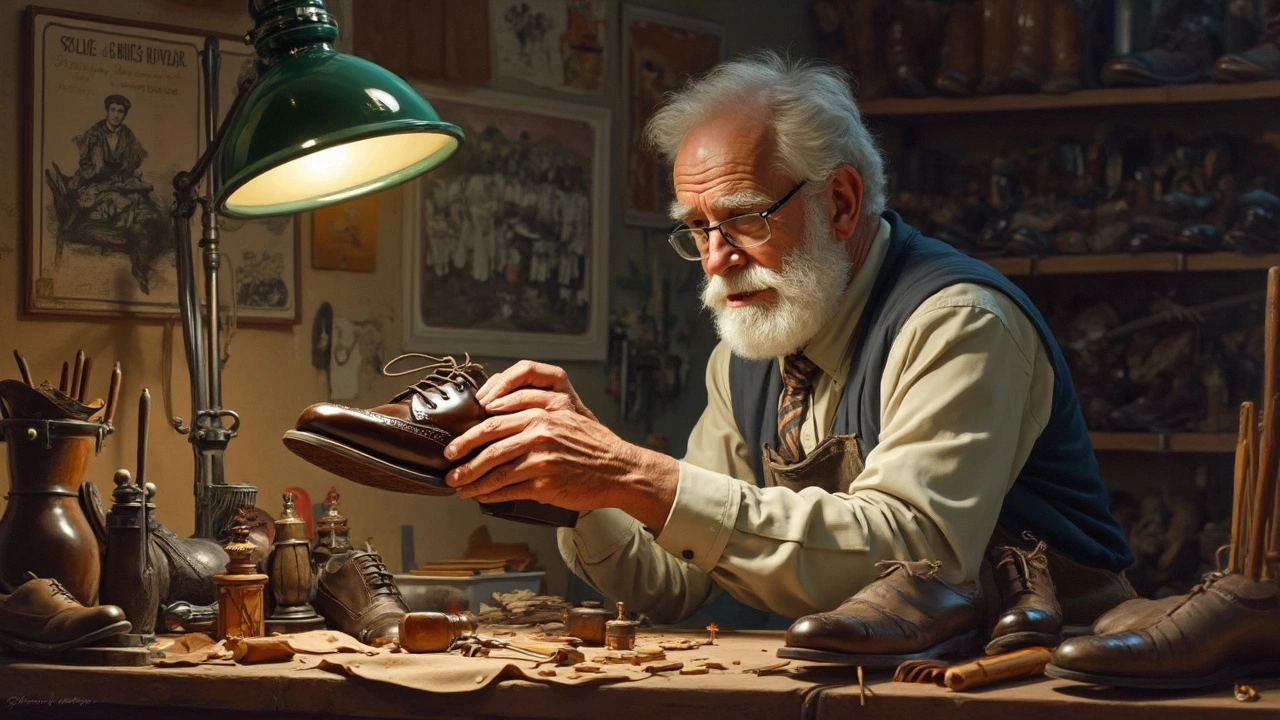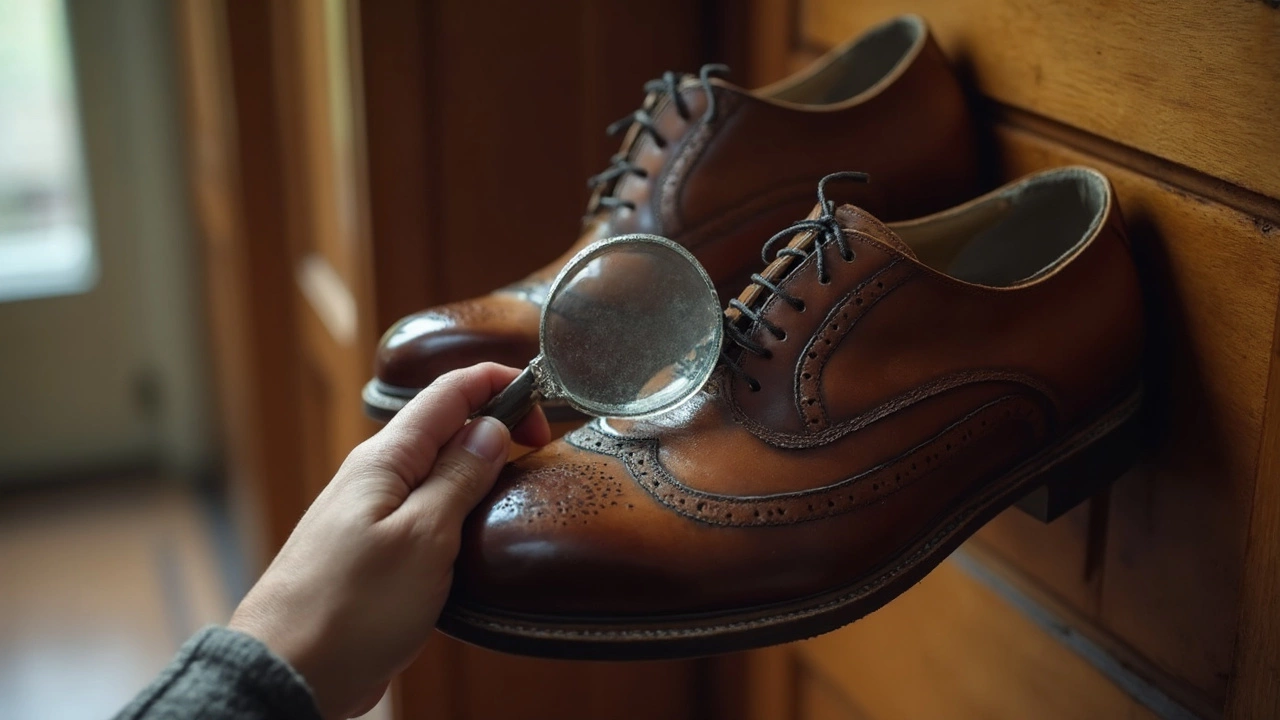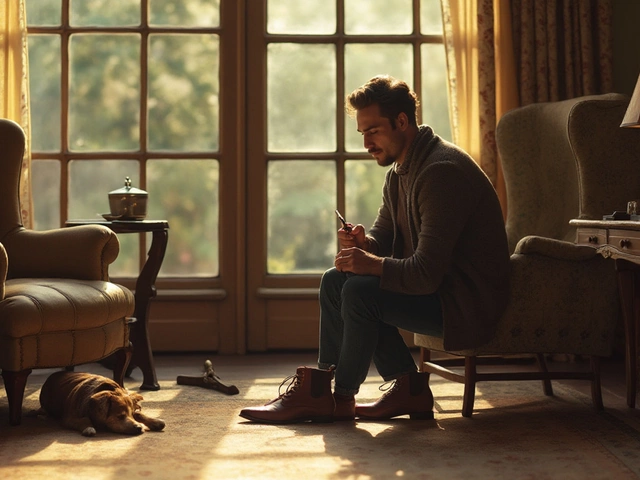If you’ve ever stared at a battered pair of leather shoes trying to decide if they deserve another round of polish or the trash bin, you’re not alone. Leather shoes get expensive, so tossing them feels wasteful, but wait too long and you’ll end up walking around with soggy soles and feet that yell at you all day.
So what’s the real tipping point? It’s not about a little scuff here or there. It’s all about checking for obvious problems—deep cracks, holes that go all the way through, or a sole that looks more like a pancake than something you’d want to walk on. If the inside’s falling apart, the backing feels like soggy cardboard, or the heel is wobbling with every step, those are solid signals it’s time to move on.
On the flip side, minor stuff like small scratches or faded color usually isn’t a big deal. That stuff is easy to fix, and most of the time, your wallet will thank you for holding off. Let’s dig into how to tell the difference between ‘time for repairs’ and ‘totally toast,’ the simple fixes that actually work, and some weird hacks to make your next pair last longer.
- Telltale Signs Leather Shoes Are Done For
- Cracks, Splits, and Unfixable Damage
- When Repairs Make Sense (Or Don’t)
- Hygiene and Odor: The Gross Truth
- How to Prolong Shoe Life Next Time
- Eco-Friendly Disposal and Alternatives
Telltale Signs Leather Shoes Are Done For
No one wants to toss their favorite shoes too early, but if you want happy feet and fresh style, you’ve got to spot when your leather shoes are actually past saving. Here’s what to check, plain and simple:
- Cracks and splits that go deep: If the leather has cracks so deep you can see the lighter layer underneath, or if it’s split, shoes are at the point of no return. Leather needs to flex, and once it shreds, there’s no easy fix.
- Holes in the toe, heel, or sole: Tiny scuffs happen—but if you’re seeing daylight through the bottom, water leaks in, or there’s a toe popping out, you’re done. Sole holes are a major sign it’s time for new shoes.
- Totally flattened or broken-down soles: Does it feel like you’re walking barefoot even with the shoes on? If the soles bend in half or have worn through the inside layer, your feet aren’t getting support. No amount of polish will save these.
- Stretched and sloppy fit: Leather can stretch a little, but if your shoes slip off with every step or the heel won’t stay up, they won’t hold shape no matter what.
- Crumbled, warped, or rotten interior: Peek inside—if the heel lining is falling apart, padding’s gone, or there are rips inside, it’s not worth fixing. Smelly, damp, or moldy interiors are a big red flag too.
- Irreparable damage from moisture: If your shoes spent a week in rain or got hit with a coffee spill and you see hard, dark, or cracked spots that won’t bounce back, that’s a killer for the leather.
One more thing—if you see nails, screws, or random bits poking out near the sole, it means the construction has basically failed. Don’t risk an injury for the sake of one last wear.
If you tick the box on any of these, saving those shoes just isn’t realistic anymore. Time to start thinking about your next pair—or maybe browse those leather conditioner bottles a bit earlier for your new favorites.
Cracks, Splits, and Unfixable Damage
Leather shoes usually give you plenty of warning before they’re beyond saving. You’ll notice the damage first—deep cracks along the flex points (like where your toes bend), splits that cut all the way through the leather, or big holes at the seams. These aren’t just ugly; they let in water, dirt, and can straight-up ruin your socks. If you spot these signs, it’s usually game over for the shoe.
Here’s the deal: most little surface cracks aren’t the end. They can be patched up or at least minimized with good conditioner. But deep, dry cracks that go through the top layer of leather have a nasty habit of splitting wide open if you keep wearing the shoes. Once the crack cuts through to the lining, it’s more likely you’ll develop blisters and your feet won’t be protected. At this point, repairs cost as much—or more—than a new pair.
Another thing to watch for is the sole. When the sole separates from the upper, it sometimes can be reglued or replaced. But if the actual leather itself is pulling away, shredded, or flopping open, there’s no real fix. Homemade jobs with glue or tape are barely a band-aid and can get messy.
Let’s lay it out with a quick cheat sheet for what’s worth fixing:
- Leather shoes with a single surface crack: Could be conditioned or patched
- Deep cracks through both sides of the leather: Beyond repair
- Soles worn flat or separating: Sometimes repairable, but check if the leather itself is also damaged
- Big splits, holes, or ripped seams: Most times, too far gone
Take a look at this table for damage types and what typically happens:
| Damage Type | Repair Options | Typical Cost | Outcome |
|---|---|---|---|
| Small surface crack | Leather conditioner, patch | $10-$25 | Often restores look |
| Deep crack/split | Patch (if shallow), replacement | $40-$100+ | Rarely worth it |
| Sole separation | Resole | $50-$90 | Good if upper is solid |
| Hole at seam/toe | Major repair or toss | $50-$100+ | Usually time to replace |
If you’ve got old shoes with cracks so deep you can see through them, it’s not just a cosmetic thing—it can wreck your posture and even cause foot pain. A shoe past its prime won’t support your foot properly. So, once the heavy damage shows up, it’s smarter (and safer) to move on to a new pair, especially if you rely on the shoes for work, walking, or standing all day.
When Repairs Make Sense (Or Don’t)
It’s easy to fall into the trap of thinking every pair of busted leather shoes is just one cobbler visit away from brand new. Truth is, not all fixes are equal—even if you love your shoes, you’ve got to weigh the repair cost against grabbing a new pair.
You want to look out for these things:
- Leather shoes with worn-out soles but a good upper can often be resoled and last a ton longer. Resoling usually costs $40–$100, depending on where you live and shoe style.
- If the leather itself is deeply cracked, ripping, or has holes—especially around toe creases or the sides—it’s game over. No cobbler is going to make that look or feel normal again.
- Loose stitching and broken eyelets? That’s usually cheap to fix, and a quick trip to the shop can make your shoes look solid again.
- Inside lining falling apart or a heel that leans (from worn-down heel counters) are bad news. If both the inside and outside are busted, ditch them.
Sometimes the math helps. Check this out:
| Problem | Average Repair Cost | Worth Repairing? |
|---|---|---|
| Worn soles | $40–$100 | Yes, if leather is healthy |
| New heels | $15–$35 | Yes, easy fix |
| Major cracks/holes in leather | Usually not offered | No, move on |
| Shredded lining | $20–$50 | No, unless sentimental |
A 2023 survey showed most people only repair shoes if the cost is less than half the price of buying the same shoes new. If you shell out $60 to fix shoes that cost you $80, you’re betting they’ll last another few years—not just a season. Be real with yourself about how bad the damage is.
Here’s a quick sniff test: if repairs just fix looks (like a polish or replacing laces), go for it. If you’re patching holes, glueing stuff on, or fighting odors that don’t quit—cut your losses.

Hygiene and Odor: The Gross Truth
Let’s be real: even the best-looking leather shoes can get nasty inside. After months (or years) of sweaty feet, all kinds of bacteria and fungi move in. That stench you can’t get rid of? It's more than just annoying. Built-up odor usually means your shoes are harboring germs that can mess with your skin, causing things like athlete’s foot or even toenail fungus.
A 2023 study from a UK podiatry clinic found that shoes worn for over a year without regular washing (and most leather pairs can't handle a spin in the machine) had 39% higher levels of bacteria that cause odor compared to those worn less than six months. If your shoes have a permanent stink even after airing out, using sprays, or stuffing them with baking soda, chances are that smell isn’t going anywhere.
Check for these red flags:
- The smell hits you even when the shoes are just sitting by the door.
- Mildew or weird stains inside the lining.
- Your socks always get damp, even after airing the shoes out.
- Your feet itch or break out after wearing them.
Here’s a quick comparison table of hygiene issues and what they mean for your shoes:
| Odor Level | What It Signals | What to Do |
|---|---|---|
| Faint, goes away with fresh air | Normal, can be fixed | Use foot powder, air them out |
| Comes back after cleaning | Odor-causing bacteria built up | Try antibacterial spray, consider new insoles |
| Pungent, won’t leave | Bacteria/fungi in lining or sole | Time to toss—they’re not sanitary |
If you find yourself reaching for heavy air fresheners every time you put on your shoes, it’s probably time to let them go. No one wants to trade comfort for fungus or constant stink.
How to Prolong Shoe Life Next Time
Your shoes can last years if you give them a little attention. Most people forget: leather is skin. It needs moisture, rest, and protection—otherwise, it’ll crack or stretch out way faster than you think. So, if you want to save money and keep your kicks fresh, check out these game-changers:
- Rotate Your Shoes: Don’t wear the same pair every day. Leather needs at least 24 hours to dry out and spring back after a day’s use. If you’ve got even two pairs to rotate, you’ll get almost double the life out of each.
- Clean Regularly: Wipe your shoes down after muddy or dusty days. Use a damp cloth, not a soaking wet one—water can wreck leather fast.
- Condition the Leather: Experts say conditioning shoes every 1-2 months keeps the leather flexible and stops cracks. Don’t cheap out on conditioner; the $12 bottle lasts forever.
- Waterproof Wisely: Spray on a waterproofer before you wear your shoes out in the rain. This shields leather and helps prevent salt stains in winter. Reapply it after a deep clean or heavy soaking.
- Use Shoe Trees: Cedar shoe trees aren’t just for show. They soak up sweat, help keep shape, and even cut down on funky smells. Your shoes won’t curl at the toes or collapse at the heels if you use them daily.
- Take Care of the Soles: If you see the soles thinning, resole them before they’re actually through. Cobblers can replace rubber and even leather soles, usually for much less than a new pair. With proper care, a good pair of leather shoes might last 5-10 years.
If you’re wondering how much this effort matters, check out this quick reference:
| Habit | Impact on Shoe Lifespan |
|---|---|
| Rotating pairs | Can double lifespan |
| Using shoe trees | Adds 1-2 years |
| Regular conditioning | Prevents early cracks (up to 60% less chance) |
| Waterproofing | Reduces water damage by over 70% |
Treat leather shoes like an investment. That little extra effort means you spend way less replacing shoes, plus your closet always smells better. You’ll never go back to walking with squishy feet and half-broken soles once you’ve seen the difference.
Eco-Friendly Disposal and Alternatives
Most people just toss old shoes in the trash, but that means they’ll end up crowding landfills for years. Leather shoes aren’t exactly quick to break down—in fact, it can take about 40 years for a leather shoe to decompose. If that sounds bad, well, there’s good news: you have way better options for getting rid of dead kicks without harming the planet.
Start with local donation spots. Even if your shoes look rough, certain charities or recycling centers will take them. Organizations like Soles4Souls, or even local clothing drives, will often take worn shoes and either recycle them for material or donate them to folks in need. Just double-check that they accept damaged footwear before dropping them off.
If the uppers are shot but the soles are still hanging in there, try shoe recycling programs. There are legit businesses and brands that break down old shoes into raw materials—Nike’s Reuse-a-Shoe, for example, grinds down old soles for playgrounds and running tracks. Search online for the nearest collection point or mail-in option.
Not game for shipping or donating? You could get creative. Repurpose old shoes as planters, doorstops, or quirky storage for keys or tools. It won’t be everyone’s style, but it does mean less waste.
| Disposal Method | What Happens to Your Shoes? | How Eco-Friendly? |
|---|---|---|
| Landfill | Sits for decades, leaks chemicals | Very Low |
| Shoe Donation | Reused or given away | High |
| Shoe Recycling | Turned into playgrounds, surfaces | High |
| DIY Repurposing | Used at home (planters, decor) | Medium |
If you’re thinking about buying new leather shoes, make your next pick eco-friendlier by looking for brands using vegetable-tanned leather or recycled components. Some eco-friendly brands even run take-back schemes for shoes at end of life.
- Always clean shoes before donating or recycling.
- Snip off laces and remove insoles—some programs recycle differently.
- Check for local drop-off bins at shoe stores, malls, or city recycling events.
Treating disposal as an afterthought just adds to landfill headaches, so try one of these next time instead of tossing them out on trash day.





